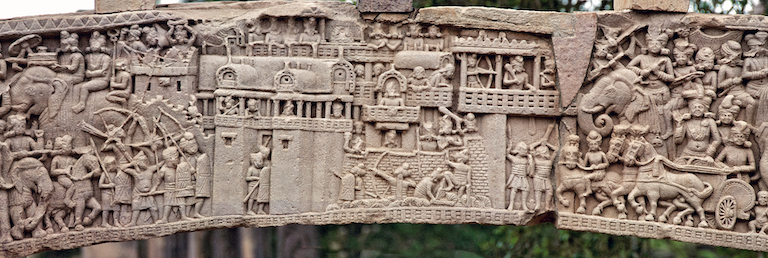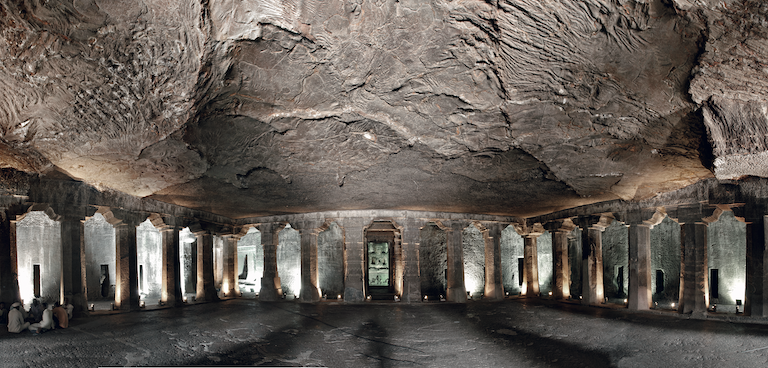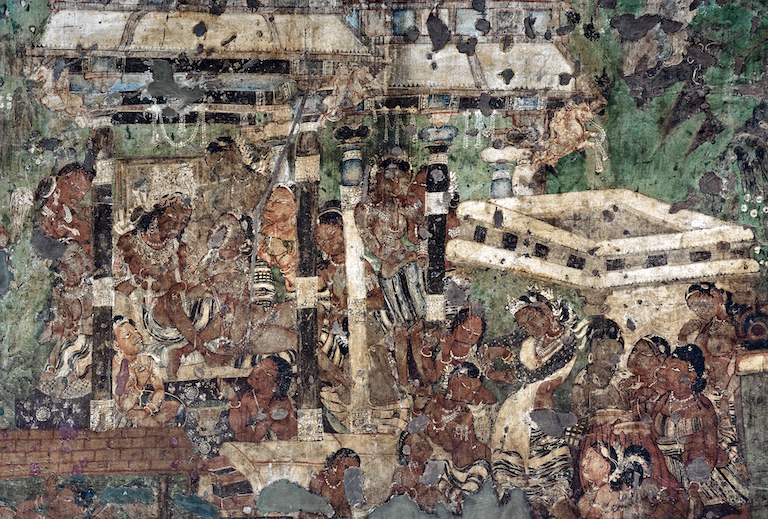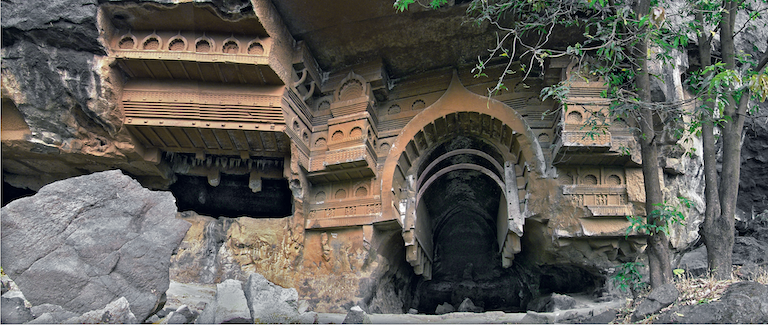Though not much remains of residential dwellings in historical times, archaeological excavations and Indian art history give many clues about the vernacular architecture in those times. The excavation reports of Mohenjodaro, Taxila, Sikrap and other sites mention very orderly planning of structures in the towns. Visible today in the excavations at Dholavira are remains of residential dwellings in circular and rectangular designs, complete with stepwells and water storage tanks.
Vernacular architecture depicted in Indian archaeological sites. Fort and palace depicted in the sculptures of a gate at the Sanchi stupa and a dwelling in the countryside
The materials used in historical vernacular buildings were mud and burnt bricks, timber,
stone, bamboo, thatch and tiles. Timber seems to be the primary material, but nothing
remains of the wood-cutting and joinery techniques except what is visible in the caves of
Karle, Kondane and Bedsa, which show that wood-crafting techniques had reached a very
high level of perfection. Some of these caves, which were constructed 1500 to 2000 years
ago, still have the wooden ribbed ceiling of exceptionally well crafted teak members, without
the use of nails.
Cave at Ajanta, Aurangabad, Maharashtra: An unfinished cave that depicts the laborious manner in which the caves were carved out of stone – scooped out and the roof chiselled to a plain surface. The columns were in the process of getting carved capitals when the construction seems to have been stopped.
Wall painting inside Cave 1, Ajanta. Apart from the Buddhist scenes depicted, insight is there in the paintings of details of the architectural elements used in structures of that time. The columns are plain wooden ones with stone bases and their circular capitals are painted with mineral colours. A tent is also depicted in one mural. This famous painting of a dancing girl performing has pavilions with wooden eaves, columns
Clues of earlier construction techniques exist not just in cave and temple architecture but
even in the wall paintings depicted at Ajanta, Badami and Bagh. The murals depict elegant
palaces and residences with graceful columns and beams, comfortable spaces, pavilions with
steps and grand structures with huge gates. The popular theme of Lord Buddha departing
from the gates of the palace are done in different styles. Even though compressed into two
dimensions the proportions seem just right. In one painting at Ajanta, Buddha is sitting
in an elaborate pavilion and is being bathed by disciples. In another painting, under a
pavilion two lovers are sitting. The capitals of some of the columns are painted in turquoise
colours, probably derived from minerals. Other paintings illustrate multi-coloured tents, and
stockades, apart from a rich array of people dressed in the best silk textiles of India, including
tie-and-dye, brocades, muslin and ikats. Hardly noticed by scholars, the Ajanta murals also
contain peculiar stone building blocks depicted behind the subjects in three-dimensions.
The Ajanta and Bagh mural themes are Buddhist but even in the earliest Hindu murals at
Badami caves, though fragmentary, the column elements are the same, as also in the Jain wall
paintings at Ellora. This indicates that the vocabulary of architecture was similar in the major
religions, centuries ago.
Cave at Kondane: The wooden window and ribbing, showing the wood craftsmanship of fifteen centuries ago. Also visible are the beams and rafters cut in stone in imitation of wood structures of that time. The wooden ribbing in the chaitya caves serves no structural purpose but was put there because of the ingrained wood construction techniques prevailing at that time.
Another source of imagery for early Indian architecture are structures depicted in Indian sculptures from Bharut, Sanchi, Sannati and other sites which date back to more than 2,000 years. Each site has its own details but the underlying style remains the same. Depicted are palaces, forts and also huts of common people of the times in forests. Groups look down from multi-storeyed balconies on activities and celebrations below. Soldiers march in and out of gates and Lord Buddha’s departure from the palace remains a favourite theme. The Bharut sculptures have graceful chaitya windows that give a very airy feel. The Sannati stupa excavation is particularly interesting as it was made during the times of Emperor Ashoka and one sculpture has an image of him 🟥
